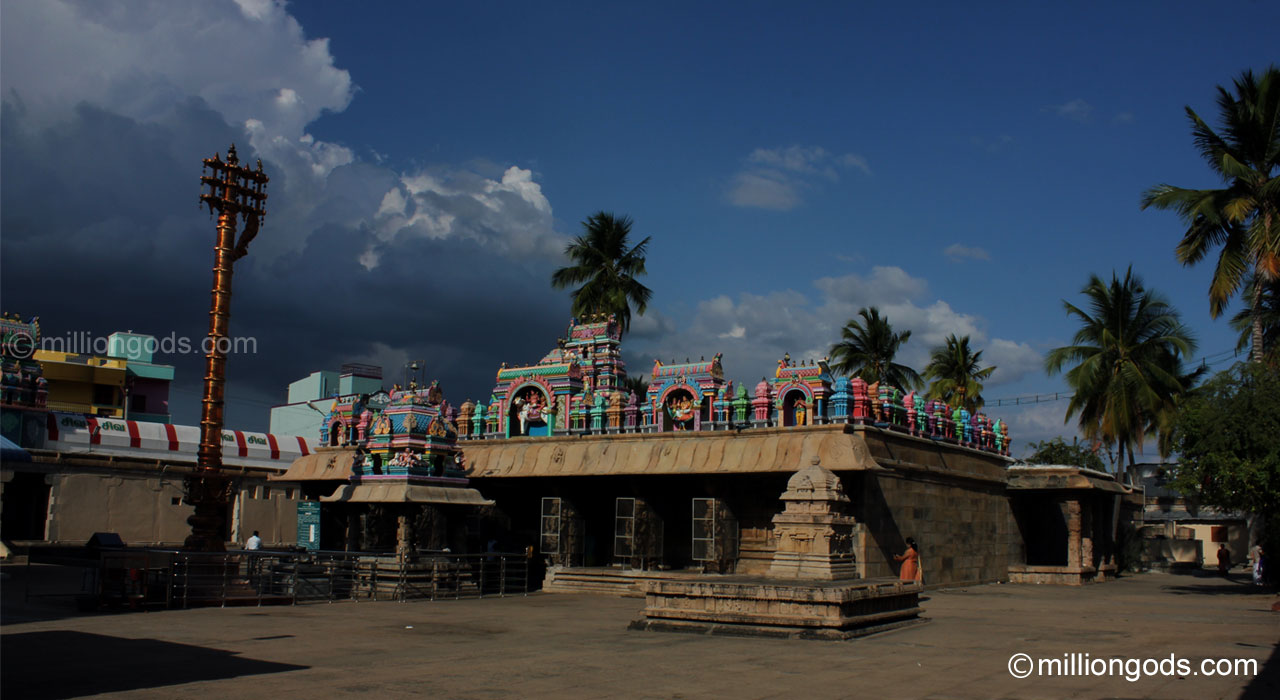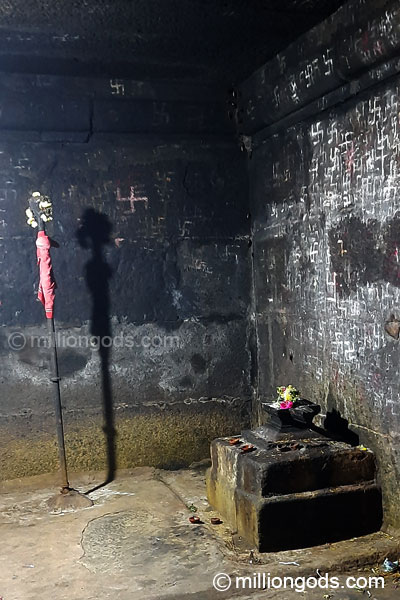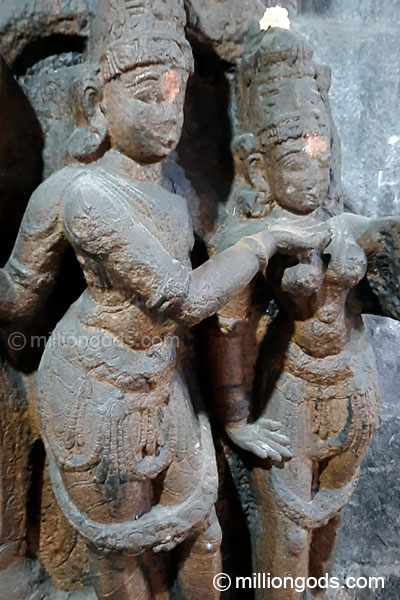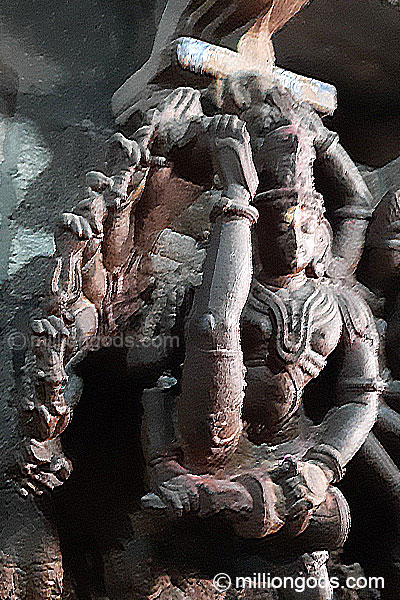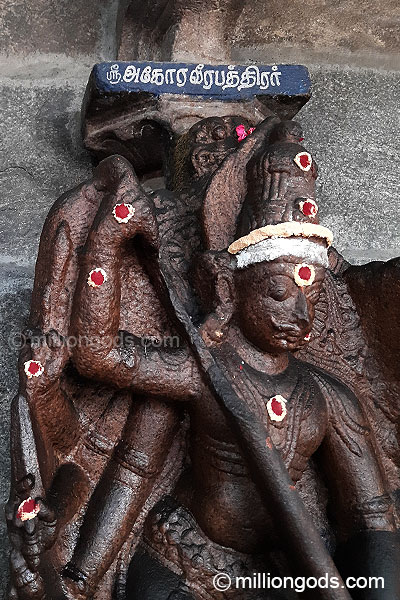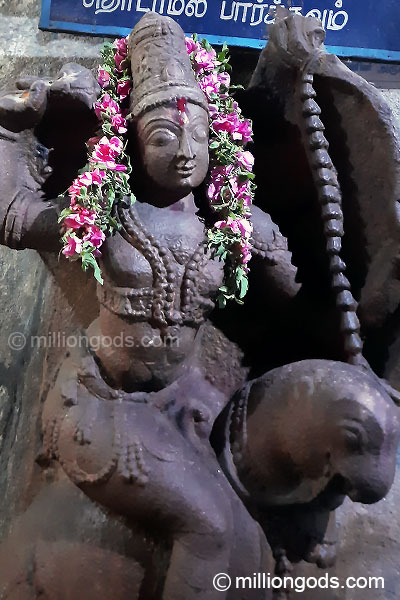Kailasanadar Tharamangalam is a large west-facing temple that is entered through a 90 feet tall 5 tiered Rajagopuram. This Rajagopuram has large and immaculate doors with 120 spikes to prevent elephants from battering them down. The Dasavatara of Lord Vishnu is carved in the panels of the doors. The Rajagopuram is at a higher elevation than the prakaram. The main step of this gopuram is made of Pavalam (Red Coral) stones. On the ceiling are the carved symbols of Chera, Chola, and Pandya Dynasties along with the Gatti Mudali Insignia. On the sides of the steps going down are carvings of beautiful Elephants and horses as if they are pulling the Gopuram on wheels like a huge chariot. On the southwest side of the outer Prakaram is the shrine of Avinasiappar with his consort Karunambikai. A little in front is a nine-pillared mandapam with the shrine of Sidhdhi Vinayaka. On the northwest side against the compound wall are the shrines of Vinayaka, Pancha Bootha Lingams. In front of these shrines are the shrines of Sahasralingam (1008 Lingams in one) and Murugan. Continuing on the outer prakaram, on the north side are the office, storeroom, library, Yagasalai amidst cloistered Mandapams. On the east side is a small east entrance gate. The Sthala Vriksham, Vilwa Tree, is on this side. On the southeast corner is the Madapalli. On the east and south sides are more cloistered mandapams. The theertham well and a shrine for Vinayaka are present here. The inner prakaram is entered from the west after crossing the Flagstaff, Balipeedam, and the Nandi Mandapam. A Mukha Mandapam is in front of the inner prakaram with some beautifully carved pillars. On the north end of this mandapam’s facade is a human face that has fine interconnected passages between the ear, nose and throat capable of allowing only minute insects to pass through. Inside the inner Prakaram, as we circumambulate, on the northwest side are 3 Vinayaka idols called Mummudi Vinayaka. This is followed by a small opening on the floor that leads down to a chamber where a small Shiva Lingam called Paadhala Lingam is installed. On the north side are Muruga, Nataraja, Juradeva, Kalabhairava and Saneeswara. On the east side are Kannivinayaka, Aadhi lingam, and his consort Uma Devi. On the south side are Saptha Maadhar, Balasubramanya and 63 Nayanmar. This is followed by Naalvar, Vinayaka, and Somaskandar on the southwest side. In the Mahamandapam facing the Lord on either side are the shrine Arumuga and Goddess Sivakami. Dwarapalakas are seen on either side of the entrance to the Ardha Mandapam. This is followed by the Sanctum Sanctorum of the main deity. In the month of February on one day towards the end of the month, the sun’s rays fall on the main deity through the horns of the Nandi giving it a crescent shape. On the pillars of the Mahamandapam are some exquisite carvings including Rama on one pillar and Vaali fighting Sugreeva on another. The way these pillars and carvings are positioned is that when you see from Rama’s side you can see Vaali but when you see from Vaali’s side Rama is not visible. In a similar way on another set of pillars are Shiva, Parvati, Manmadha, and Rati. Manmadha can see Shiva, but Shiva cannot see Manmadha. Around the inner Prakaram are some truly excellent carvings with minute details including Oorthuvathandavar, Hyagrivar, Pitchadanar, Agora Veerabadhra, Agni Veerabadhra, Pradosha Nayakar, Dakshinamurthy, Kaali, Brahma, Kanchi Kamakshi, Sage Pathanjali, Sage Vyagrapadar, Siva Shakthi, Nataraja, and others. Also in some of the Yaali pillars are balls that rotate inside the mouth, but cannot be taken out, carved out of single stones. On the ceiling in the Mahamandapam in front of the entrance to the Ardha Mandapam is another exquisite ornamental carving of an inverted lotus with an inner circle of 8 hanging parrots. The innermost stone circle can be rotated with a long pole. Outside the circle of parrots is an ornamental square with carvings of swans and hanging stone chains in the corners. Each of these chains are carved out of a single stone and each link rotates independently. The priest sometimes demonstrates the rotation on request. From the side of the lotus is a monolith carved stone chain that hangs down. The exit from the Mahamandapam is on the south through a mandapam leading to the outer Prakaram. Huge stone pillars brought to create a 1000 pillared mandapam are found lying outside the temple and the mandapam is yet to be finished. There are two temple tanks behind the temple on the east side. One has the carvings of 36 Nandi idols around it and another is in a circular shape with the hexagonal and rectangular arrangement of steps around. There is said to be a secret passageway from Kailasanadar Tharamangalam leading to the Chokkanadar temple at Amarakunthi, about 5 kilometers to the north.
